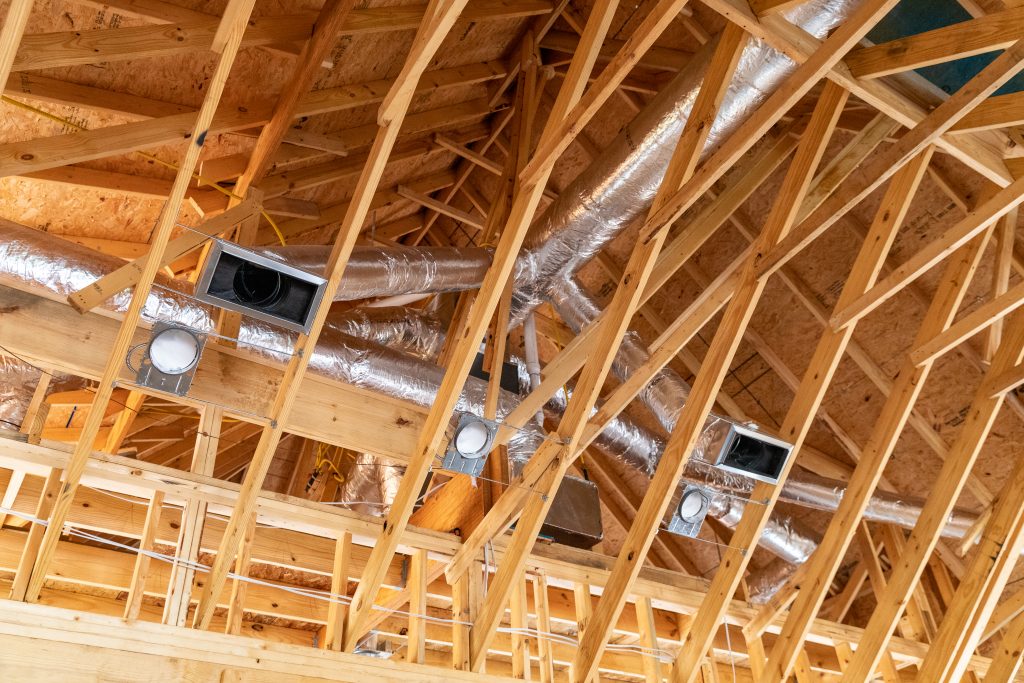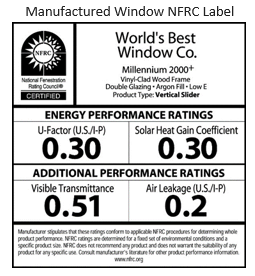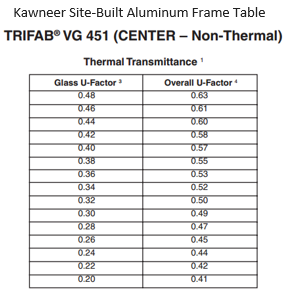
Thermal Factors – R-values, U-factors & SHGCs – Consistency on all Construction Documents
Question: I submitted plans to a city for review, which was rejected because the R-values on the plan sheets did not match the R-values on the REScheck or COMcheck. Why are they being so nit-picky?
Thermal Factors- R-values, U-factors & SHGCs – Consistency on all Construction Documents
The IECC requires commercial and residential HVAC system sizing and selection in accordance with specific ASHRAE or ACCA Standards and requires complete construction documents:
Commercial Buildings
C403.1.1 Calculation of heating and cooling loads. Design loads associated with heating, ventilating, and air conditioning of the building shall be determined in accordance with ANSI/ASHRAE/ACCA Standard 183 or by an approved equivalent computational procedure using the design parameters specified in Chapter 3.
C103.2 Information on construction documents. Construction documents shall be drawn to scale on suitable material. Electronic media documents are permitted to be submitted where approved by the code official. Construction documents shall be of sufficient clarity to indicate the location, nature and extent of the work proposed, and show in sufficient detail pertinent data and features of the building, systems, and equipment as herein governed. Details shall include, but are not limited to, the following as applicable:
-
- Insulation materials and their R-values.
- Fenestration U-factors and solar heat gain coefficients (SHGCs).
- Area-weighted U-factor and solar heat gain coefficient (SHGC) calculations.
- Mechanical system design criteria.
- Mechanical and service water heating systems and equipment types, sizes, and efficiencies.
- Economizer description.
- Equipment and system controls.
- Fan motor horsepower (hp) and controls.
- Duct sealing, duct and pipe insulation and location.
- Lighting fixture schedule with wattage and control narrative.
- Location of daylight zones on floor plans.
- Air sealing details.
Residential Buildings
R403.7 Equipment sizing and efficiency rating (Mandatory). Heating and cooling equipment shall be sized in accordance with ACCA Manual S based on building loads calculated in accordance with ACCA Manual J or other approved heating and cooling calculation methodologies.
R103.2 Information on construction documents. Construction documents shall be drawn to scale on suitable material. Electronic media documents are permitted to be submitted where approved by the code official. Construction documents shall be of sufficient clarity to indicate the location, nature and extent of the work proposed, and show in sufficient detail pertinent data and features of the building, systems, and equipment as herein governed. Construction documents include all documentation required to be submitted in order to issue a building permit. (red text indicates a Utah amendment)
No, the plans examiner is not fussy, nit-picky, or simply trying to make your life miserable. The issue is it’s critically important to provide a full complete set of construction documents, including accurately listing correct R-values, U-factors, and Solar Heat Gain Coefficients (SHGCs) on the plans, load calculation, specifications manuals, COMcheck and REScheck energy code compliance certificates, ALL construction documents. These thermal factors, along with the difference in temperature between inside and outside the building, are used to calculate the heat loss and gain through the building envelope. If load calculations are based on incorrect performance factors, the HVAC equipment will be incorrectly sized. Let us consider a few definitions.
R-value: (Thermal Resistance) The capacity of an insulating material to resist heat flow. The higher the R-value, the greater the insulating power. Typically used to identify the thermal performance of insulation products, including fiberglass batts, blown fiberglass, cellulose, foam insulation panels, spray foam and other building insulation products.
U-factor: (Thermal Transmittance) The rate of heat loss is indicated in terms of the U-factor of construction assembly. U-factors are typically used to represent the thermal performance of windows; however, also used to calculate the heat flow through wall, roof, and floor construction assemblies. The lower the U-factor, the greater the assembly’s resistance to heat flow and the better its insulating properties. The U-factor is the reciprocal of the R-value, the R-value the reciprocal of the U-factor.
SHGC: (Solar Heat Gain Coefficient) The fraction of incident solar radiation admitted through a window, both directly transmitted and absorbed and subsequently released inward. SHGC is expressed as a number between 0 and 1. The lower a window’s solar heat gain coefficient, the less solar heat it transmits. A window with a SHGC of 0.30 will allow 30% of the solar radiation (heat in the sun’s rays) in through the window, reflecting 70% of the heat in the sun’s rays back outside. A low SHGC reduces summer heat gain through east and west windows.
Applying formulas and making basic calculations will show the need to be accurate. Beginning with the reciprocal relationship between R-values and U-factors, expressed in a couple of simple equations, applied to windows:
R = 1÷U and U = 1÷R
Example: A window with an assembly 0.33 U-factor, R = 1 ÷ U → R = 1 ÷ 0.33 → R = 3.0. Yes, a window with a 0.33 U-factor is a R-3 window.
For every degree temperature difference between inside and outside, 0.33 BTU/hr. of heat will be transferred. Considering 500 sq. ft. of glass, with an indoor temperature of 70⁰F and an outside temperature of 10⁰F, for a temperature difference of 60⁰F:
60 X .33 X 500 = 9,900 BTU/hr heat loss through the windows.
It is critical to remember U-factors are for an entire assembly, all the components of the window or other building component. The U-factor on the window label is an area weighted average of the U-factors of both the frame and glass. As vinyl is a better insulator (lower U-factor) than aluminum, vinyl windows will have a lower assembly U-factor than aluminum windows with similar glass. New manufactured windows will include a NFRC Label which includes the assembly U-factor and SHGC.


The issue with windows, especially in large commercial buildings, is the windows are often site-built, i.e., frames from one manufacturer, and the IGU (insulated glass unit) from another. If the IGU center of glass U-factor is 0.26, and the assembly U-factor for the IGU in non-thermal break aluminum frames is 0.45. Failure to accurately identify the window U-factor on construction documents will lead to a significant error. (See Table) Considering a moderate sized commercial building with 14,000 sq.ft. of glass, if we repeat the calculation above for the correct and incorrect window assembly U-factors, with the same 60⁰F temperature difference:
60 X 0.26 X 14,000 = 218,400 BTU/hr. This is not an accurate U-factor or load
60 X 0.45 X 14,000 = 378,000 BTU/hr. This is the accurate, actual load, 160,000 BTU/hr. higher than calculated with an incorrect U-factor. Further, these U-factors are not typically IECC code compliant.
The numbers calculated above apply to the heating portion of the system. Similar, even worse inaccuracies will occur when we consider the cooling systems and apply SHGCs. For additional information on this subject, please see https://utahenergycode.com/commercial-code/ for the April 30, 2020 -Commercial IECC: Energy Performance Ratings for Windows, Doors, and Skylights Webinar.
Considering R-19 fiberglass batts in 2X6 wall cavities; we do not calculate the U-factor for the wall by simply using the equation above. The R-value in the cavity is R-19; however, the R-value of the wood studs and plates is approximately R-1 per inch, or R-6 for all the wall area that is wood framing. An area weighted average calculation performed, for a wall with studs on 16” centers, results in a R-14 for the wall assembly. The U-factor for this wall will be 1 ÷ 14 = 0.07
Architects, builders, HVAC contractors, insulation contractor, window suppliers, plans examiners, building inspectors and homeowners should understand inconsistencies in the R-values, U-factors and SHGCs on construction documents, may result in improper HVAC system design. I often review plans with R-values lower than the R-values listed on the load calculation and the REScheck. Builders are upset when I reject the plans and require corrections, when I’m simply attempting to insure the home is comfortable and energy efficient. A load calculation based on inaccurate R-values, U-factors and SHGCs will not accurately represent the actual building heat loss and heat gain.
Please feel free to respond with comments or questions.
– Dr. Energy

0 Comments